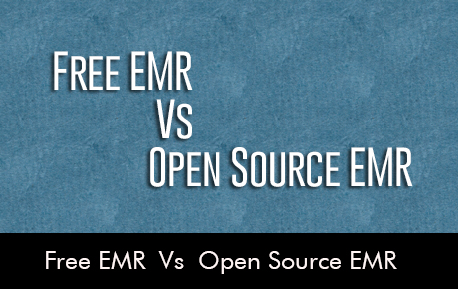Healthcare Software Industry often assumes that the terms Free EMR Software and Open Source EMR Software are interchange-able, even though they actually have a difference in approach in terms of development models. EMR Software providers often prefer the term “open source” because it offers a clearer and more understandable description.
Due to complex legalities, technicalities and jargon physicians often show some confusion. Do keep in mind that Free Electronic Health Records (EHR) and Practice Management (PM) software systems do not have any upfront cost or ongoing fees. But this doesn’t translate to a zero cost or a freeware Software. To eradicate this confusion in the simplest terms here is the difference between a Free EMR Software and an Open Source EMR Software.
Free EMR Software
Free Software gives you the ability to change/update/alter the code through a collaborative software development environment to suit the unique need of your practice.
Free Software Foundation (FSF), a nonprofit organization dedicates guarantees that software should offer to be considered as free under the GNU (General Public License)
- The software can be used for any specialty-specific practice.
- The software should authorize access behind the curtain and any changes to the code.
- The software can be redistributed as the original.
- The software can be distributed as copies of your modified versions to others.
Features of Free EMR Software
To have a good understanding of how the software works, it is advisable to learn about the different features and functionalities of the software. Before choosing Free EMR software, you should check if the software has the following key features:
-
Clinical charting
-
Decision Support through Dashboards
-
Coding Assistance
-
Appointment scheduler
-
Dashboard
-
e-claims submissions
-
Invoicing
-
Patient portal
-
Integrations through Labs API, imaging API, and billing API
Top Free EMR Software by EMRSystems
EMRSystems have compiled a list of the top Free EMR and PM Software vendors ideal for your practice:
Open Source EMR Software
Open-source software source code is publically available and anyone can inspect, modify, and build on it. Even though it often requires hiring a development team initially Medical Practices prefer an open-source EMR software because it offers more control, more security, and stability. It improves the practice workflow by streamlining clinical activities.
The Open Source Initiative (OSI) developed the commandments for software to be categorized as an Open Source Software some of which are.
- The software must allow distribution in source code as well as compiled form.
- No restriction in selling or giving away the software as a component of a larger software
- The Software must allow modifications under the license of the original software.
- The software keeps the integrity of the Author’s Source Code intact as the source code will be modified only if the license allows the distribution of patch files.
- IF you want to know more about the legalities and bottom-up development process of an Open Source EMR Software opensource.com article is quite insightful.
Features of Open Source EMR Software
To have a good understanding of how the software works, it is advisable to learn about the different features and functionalities of the software. Before choosing an Open Source EMR software, you should check if the software has the following key features:
-
Patient Scheduling
-
E-Prescribing
-
Medical Billing
-
CMS Reporting
-
Lab Integration
-
HIPAA Compliant Security
-
Multilingual Support
-
Patient Portal
-
Clinical Document Management
-
Extensive functionality including Coding and RCM
Top Open Source EMR Software by EMRSystems
EMRSystems have compiled a list of the top Open EMR and PM software vendors ideal for your practice:
Although there are many advantages of choosing a Free or an Open Source EMR software solution, it is important to note some of the potential limitations associated such as lack of integrated Practice Management or medical billing functionality, limited e-Rx features, lack of extensive financial reporting, and ads, etc.







